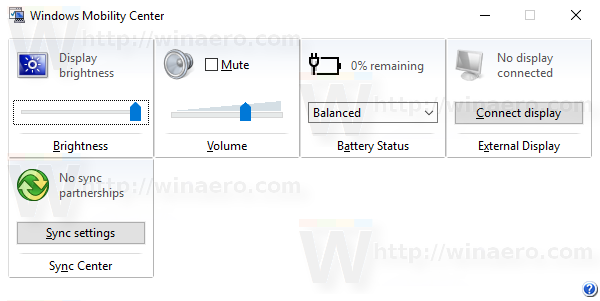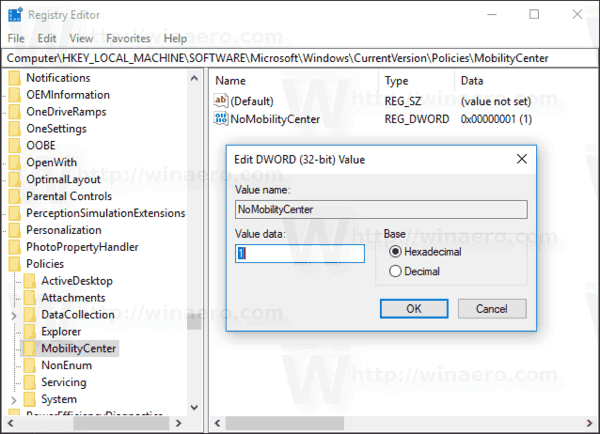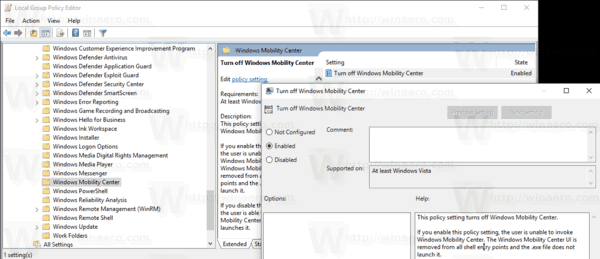Windows Mobility Center (mblctr.exe) is a special app that comes bundled with Windows 10. It is present by default on mobile devices like laptops and tablets. It allows changing brightness, volume, power plans, display orientation, display projection, Sync Center settings, and presentation settings of your device. There are situations when you may need to disable Windows Mobility Center for all user accounts of your device. Here is how it can be done.
Advertisеment
Windows Mobility Center was first introduced in Windows 7. Windows 8, Windows 8.1 and Windows 10 also include it, however it is mostly superseded by Action Center's buttons for quickly toggling these above mentioned settings. Still if you prefer to use Mobility Center, you can activate it on a Desktop computer. It can still be useful because it can be extended by OEMs (your PC vendor) with additional tiles to toggle various system settings like Bluetooth or your monitor.

Here is how you can disable this feature for all users. You must be signed in with an administrative account to continue.
To disable Mobility Center in Windows 10, do the following.
- Open Registry Editor.
- Go to the following Registry key:
HKEY_LOCAL_MACHINE\SOFTWARE\Microsoft\Windows\CurrentVersion\Policies\MobilityCenter
Tip: See how to jump to the desired Registry key with one click.
If you do not have such a key, then just create it.
- Here, create a new 32-bit DWORD value NoMobilityCenter.
Note: Even if you are running 64-bit Windows, you still need to use a 32-bit DWORD as the value type.
Set it to 1 to disable the Windows Mobility Center app in Windows 10.
- To make the changes done by the Registry tweak take effect, you need to Restart Windows 10.
Later, you can delete the NoMobilityCenter value to allow the user to use both Control Panel and Settings.
Disable Windows Mobility Center for a Specific User
To disable the Windows Mobility Center for a specific user account, apply the same tweak under the HKEY_CURRENT_USER branch. Tip: You can switch between HKCU and HKLM in Windows 10 Registry Editor quickly.
- Open Registry Editor.
- Go to the following Registry key:
HKEY_CURRENT_USER\Software\Microsoft\Windows\CurrentVersion\Policies\MobilityCenter
Tip: See how to jump to the desired Registry key with one click.
If you do not have such a key, then just create it.
- Here, create a new 32-bit DWORD value NoMobilityCenter.
Note: Even if you are running 64-bit Windows, you still need to use a 32-bit DWORD as the value type.
Set it to 1 to disable the Windows Mobility Center app in Windows 10 for the current user. - To make the changes done by the Registry tweak take effect, you need to sign out and sign in to your user account.
To save your time, I made ready-to-use Registry files. You can download them here:
Disable Windows Mobility Center with Local Group Policy Editor
If you are running Windows 10 Pro, Enterprise, or Education edition, you can use the Local Group Policy Editor app to configure the options mentioned above with a GUI.
- Press Win + R keys together on your keyboard and type:
gpedit.msc
- Group Policy Editor will open. Go to Computer Configuration\Administrative Templates\Windows Components\Windows Mobility Center. Enable the policy option Turn off Windows Mobility Center as shown below.

This policy setting turns off Windows Mobility Center. If you enable this policy setting, the user is unable to invoke Windows Mobility Center. The Windows Mobility Center UI is removed from all shell entry points and the .exe file does not launch it.
That's it.
Support us
Winaero greatly relies on your support. You can help the site keep bringing you interesting and useful content and software by using these options:

